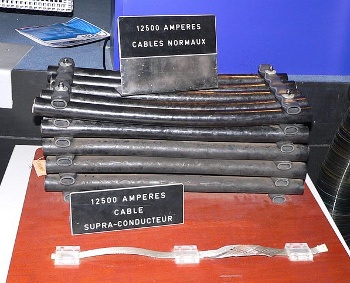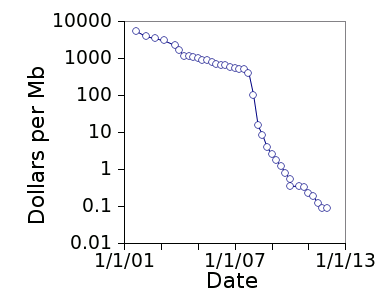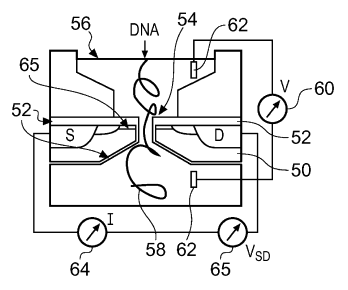Full Genome Sequencing
June 7, 2012
Our
technology is a direct result of
scientific research. Sometimes this research seems so
basic, that it has no direct benefit when it's done. That was true for
electricity in its early days, and it led to
Michael Faraday's famous response in 1850 to
Chancellor of the Exchequer,
William Gladstone, question whether electricity had any practical value, "
One day sir, you may tax it."
In the case of electricity, it was less than a hundred years between
Alessandro Volta's invention of the
battery to public use of electricity. For
mathematics, this time delay can be many hundreds of years.
Prime numbers and the
sieve of Eratosthenes go back two
millennia, and now prime numbers are the basis of
public-key cryptography.
Science and technology are complementary to some extent. Advances in technology allow the fabrication of better
scientific instrumentation. As an example, the
Large Hadron Collider at
CERN would not be possible without
superconducting magnets and
powerful computers for
data analysis.

Technology has shrunk more than computers.
This photograph compares the size of a conventional cable, and a superconducting cable of the same capacity.
(Photograph by Rama, via Wikimedia Commons)
One area in which technology is having a big impact is in the
sequencing of DNA. I reviewed some of this technology in a
pevious article (DNA Analysis, September 17, 2010). In the past, DNA analysis was viewed as a
chemical problem, and
analytical chemistry is usually expensive (Ask any scientist who has had to pay for some analytical equipment, or analytical services!).
Fortunately,
automation techniques had advanced to the point at which
genetics pioneer,
James D. Watson, had his
genome sequenced by advanced chemical techniques in 2007 for less than a million dollars in two months.[1] The human genome has about 3,000
megabase pairs (Mb). The cost of a whole genome analysis is presently about $10,000. That's a two orders or magnitude drop in price in just five years.
There's a web site (
http://www.genome.gov/sequencingcosts)[2] that tracks the cost of DNA sequencing. The recent cost data, as shown in the following graph, shows the rapid progress that's been made in recent years.

Cost per megabase (Mb) for DNA sequencing. The human genome is 3,000 Mb in size.
Data from ref. 2.
(Graph by the author, rendered with Gnumeric)
Of course, $10,000 is still a lot of money, and there's a desire to make such an analysis as inexpensive as a
blood test, or a cost reduction of another two orders of magnitude. One thing that might allow this is a shifting of the measurement
paradigm from chemistry to
physics.[3]
Some of the non-chemical techniques for DNA sequencing have included
scanning tunneling microscopic imaging,[4] and looking at
conductivity changes when DNA is threaded through
nanopores in
graphene.[5-7] The graphene technique builds on
nanopore sequencing work done over the course of the last decade.[8]
Nanopores and
electronics are common to many of the new DNA sequencing devices, one of which is shown in the figure below from a US
patent application.[9] In this case, the DNA is threaded through a nanopore in the
gate of a
field effect transistor.

Figure one of US Patent application 12/595,090, "Apparatus And Method For Molecule Detection Using Nanopores," by Matthias Merz, Youri V. Ponomarev and Gilberto Curatola (April 5, 2008).
(Via Google Patents))
An
editorial summarizing such DNA detection methods was published in
Nature Nanotechnology at the end of 2010.[10] That same issue contained an article by
Stuart Lindsay and his team at
Arizona State University, who have improved DNA sequencing through the use of
quantum tunnelling.[11-12]
The Arizona team functionalized a
gold surface and the tip of a scanning tunnelling microscope with
benzamide (C
6H
5CONH
2), which
hydrogen bonds to DNA. The individual DNA bases can be distinguished by the tunnelling
voltage as the DNA strand is scanned.[11] Such an effect can be used with nanopore devices.
References:
- Nicholas Wade, "Genome of DNA Pioneer Is Deciphered," New York Times, May 31, 2007.
- K.A. Wetterstrand, "DNA Sequencing Costs: Data from the NHGRI Large-Scale Genome Sequencing Program," Web site for data from the the NHGRI Large-Scale Genome Sequencing Program.
- E.R. Mardis, "A decade's perspective on DNA sequencing technology," Nature, vol. 470, no.7333 (February 10, 2011), pp. 198-203.
- D. Dunlop, "Scanning tunneling microscopy of DNA," Engineering in Medicine and Biology Magazine, vol. 15, no. 1, pp. 46-50.
- Michael Patrick Rutter, "Graphene may hold key to speeding up DNA sequencing," Harvard University Press Release, September 9, 2010.
- Hagan Bayley, "DNA sequencing: enter the graphene nanopore," Nature, vol. 467, no. 7312 (September 9, 2010), p. 164.
- S. Garaj, W. Hubbard, A. Reina, J. Kong, D. Branton and J. A. Golovchenko, "Graphene as a subnanometre trans-electrode membrane," Nature, vol. 467, no. 7312 (September 9, 2010), pp. 190-193.
- Amit Meller, Lucas Nivon, Eric Brandin, Jene Golovchenko, and Daniel Branton, "Rapid nanopore discrimination between single polynucleotide molecules," Proc. Natl. Acad. Sci., vol. 97, no. 3 (February 1, 2000), pp. 1079-1084.
- Matthias Merz, Youri V. Ponomarev and Gilberto Curatola, "Apparatus And Method For Molecule Detection Using Nanopores," US Patent application 12/595,090, April 5, 2008.
- Editorial - Quantum steps to better sequencing, Nature Nanotechnology, vol. 5, no. 12 (December, 2010).
- Shuo Huang, Jin He, Shuai Chang, Peiming Zhang, Feng Liang, Shengqin Li, Michael Tuchband Alexander Fuhrmann, Robert Ros and Stuart Lindsay, "Identifying single bases in a DNA oligomer with electron tunnelling," Nature Nanotechnology, vol. 5, no. 12 (December 2010), pp. 868-873.
- Joseph Caspermeyer, "A new read on DNA sequencing," Arizona State University Press Release, November 14, 2010.
Permanent Link to this article
Linked Keywords: Technology; science; scientific; research; pure research; basic research; electricity; Michael Faraday; Chancellor of the Exchequer; William Gladstone; One day sir, you may tax it; Alessandro Volta; battery; mathematics; prime number; sieve of Eratosthenes; millennia; public-key cryptography; scientific instrumentation; Large Hadron Collider; CERN; superconducting magnet; supercomputer; data analysis; superconducting cable; Wikimedia Commons; DNA sequencing; sequencing of DNA; chemistry; chemical; analytical chemistry; automation; genetics; James D. Watson; genome; megabase pairs; Gnumeric; complete blood count; blood test; paradigm; physics; scanning tunneling microscope; conductivity; nanopore; graphene; nanopore sequencing; electronics; patent application; gate; field effect transistor; Google Patents; editorial; Nature Nanotechnology; Stuart Lindsay; Arizona State University; >quantum tunnelling; gold; benzamide; hydrogen bond; voltage; US Patent application 12/595,090.